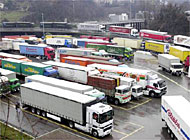Swiss and Italian authorities grapple with traffic jams at Chiasso border

A decision to keep the Chiasso border post open for goods traffic overnight in the run up to Easter has been greeted with relief by the Swiss Road Transport Association, Astag, and the population of canton Ticino.
The measure, announced this week by a government-appointed task force, is expected to ease kilometre-long tailbacks on Europe’s main north-south axis. It will remain in force until the A2 motorway has been cleared of commercial lorries.
In the past month, hundreds of lorries have clogged the artery because of a bottleneck at the Chiasso customs checkpoint. The congestion had hampered deliveries to shops in Ticino and slowed down normal traffic.
The measure, taken jointly by the Swiss and Italian governments, was welcomed by Astag. Spokesman, Beat Keiser, blamed the congestion on the “ever-increasing traffic in trans-European haulage” and said that “domestic lorry drivers as well as the public in general are their victims”.
A spokeswoman for the transport ministry of canton Ticino, Ilaria Bignasci, also said she was happy with the measure. However, she added that “we would have preferred an outright ban on heavy traffic at least on the Thursday before Easter”.
The main beneficiaries of the measure, which exempts lorries from a normal night time ban in place throughout Switzerland, are likely to be the tens of thousands of holiday-goers from across Europe who drive through Switzerland to get to their Easter holiday destinations.
Easter traffic congestions on the A2 have become almost routine over the past few years, but never before have they occurred so early during springtime, and involved commercial haulage on top of the “normal” holiday congestions.
The Swiss press, as well as politicians, have blamed recent policy changes for the worsening situation. At the beginning of 2001, Switzerland introduced a new road haulage tax and implemented its part of a bilateral agreement with the European Union (EU).
Foreign goods lorries now have to pay a flat rate of €200 for a transit passage through Switzerland from Basel to Chiasso or vice-versa. At the same time, Switzerland opened its roads to lorries that weigh up to 34 tons and to a limited number of lorries that weigh up to 40 tons.
But Felix Walter, the head of a government sponsored research programme on transport policies, told swissinfo that the normal growth trend, rather than recent policy changes, were responsible for the breakdown in north-south traffic.
“The effects of tolerating heavy lorries and the new tax cancel themselves out”, Walter said. “In fact, it is the annual increase of goods traffic that creates congestions; as it happens, the bottleneck this time round is in customs checks at the Chiasso border.”
Walter said some such breakdown had been anticipated long ago. “Our estimates have always been that transit road haulage through Switzerland will increase from the present 1.2 million lorries per year to about 1.6 million by the end of the decade, when it will decrease again and stabilise at about 1.2 million”, he said.
The reason for the envisaged decrease lies in Switzerland’s trans-alpine railway network (Neat), which is expected to become operative in 2007 on its western (Lötschberg) axis and in about 2013 on its eastern (Gotthard) axis.
As a medium-term measure, train haulage for lorries will be available between Freiburg (in south Germany) and Novara (in northern Italy) from June this year. However, the capacity of the haulage facility stands at a maximum of 280 lorries per day for the time being – that is less than five per cent of the cross-border transit of 6,000 vehicles that cross Switzerland daily.
Transport experts and politicians alike agree that the Swiss and Italian governments’ measure, taken on Monday, is even more short-term. But they disagree sharply on medium and long-term measures.
“What’s necessary now is that the Swiss government begins construction of a second road tunnel through the Gotthard”, says Ulrich Giezendanner, a politician and member of Astag. “That’s the only way to cope with the annual increase of three to five per cent in road haulage the EU predicts.”
Others, however, disagree. “Never mind that a second road tunnel through the Gotthard is highly controversial”, says Hanspeter Guggenbühl, a journalist who writes on transport policies. “The tunnel would take 10 to 15 years to build, by which time traffic would have at least doubled at the present rate.”
Hans-Kaspar Schiesser of the (ecologically oriented) Swiss Transport Association (ATS) said Switzerland should introduce new by-laws, like speed limits for lorries and compulsory fire-fighting equipment for tunnel passages.
“That way, only modern lorries would be allowed into the country, and the ensuing reduction in traffic would give us some breathing space until the Neat rail link becomes operative,” Schiesser said.
Policy expert, Walter, says the only way to deal with the problem in the long run is to make road haulage more expensive. “The elegant way is for a Europe-wide road tax akin to our Swiss road transport tax”, he told swissinfo.
“But until this happens, unfortunately it’s tailbacks and congestions that will do the job. They aren’t very elegant, but at least they make road haulage more expensive too,” Walter said.
by Markus Haefliger

In compliance with the JTI standards
More: SWI swissinfo.ch certified by the Journalism Trust Initiative
You can find an overview of ongoing debates with our journalists here. Please join us!
If you want to start a conversation about a topic raised in this article or want to report factual errors, email us at english@swissinfo.ch.